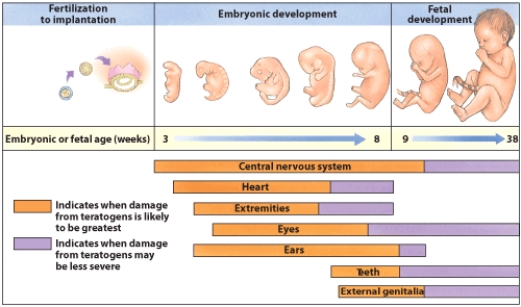Correct Answer

verified
Correct Answer
verified
True/False
Newer research indicates that calcium may play a role in preventing hypertensive disorders of pregnancy.
Correct Answer

verified
Correct Answer
verified
True/False
Maternal malnutrition can affect their child's risk of developing chronic disease later in life.
Correct Answer

verified
Correct Answer
verified
True/False
Food allergies are more common in infants less than 3 months of age because they lack the ability to completely digest protein.
Correct Answer

verified
Correct Answer
verified
Multiple Choice
Because the majority of cell differentiation occurs during the ____ phase, this is the time when exposure to teratogens can do the most damage.
A) embryonic
B) fetal
C) implantation
D) zygote
Correct Answer

verified
Correct Answer
verified
True/False
Implantation is complete by 14 days after fertilization.
Correct Answer

verified
Correct Answer
verified
Multiple Choice
The fetus gets nourished by
A) absorbing nutrients for the bloodstream of the mother (the bloodstream of the embryo mixes with the bloodstream of the mother) .
B) breaking down the lining of the uterus.
C) transferring of nutrients from the placenta.
D) none of these
Correct Answer

verified
Correct Answer
verified
Multiple Choice
As a general rule of thumb, an infant should ______ her birthweight by her first birthday.
A) double
B) triple
C) quadruple
D) Weight gain in infancy is not compared to birthweight.
Correct Answer

verified
Correct Answer
verified
True/False
Fluoride is important for tooth development, even before the teeth erupt.
Correct Answer

verified
True
Correct Answer
verified
True/False
The distribution of kcalories from the energy-yielding macronutrients remains very similar between pregnant and nonpregnant women.
Correct Answer

verified
Correct Answer
verified
Multiple Choice
Which of the following statements is FALSE?
A) Folate needs are increased during lactation because it is secreted in the breastmilk.
B) Vitamin B₁₂ may be deficient in the breast milk of vegan mothers.
C) Iron needs are increased during lactation as it is secreted in the breastmilk.
D) Increasing calcium intake during lactation does not prevent loss of calcium from maternal bones.
Correct Answer

verified
Correct Answer
verified
True/False
Breastmilk is low in vitamin D.
Correct Answer

verified
Correct Answer
verified
Multiple Choice
DHA is made from ____ fatty acids while ARA is made from _____ fatty acids.
A) omega 3, omega 6
B) omega 6, omega 3
C) trans, polyunsaturated
D) omega 3, trans
Correct Answer

verified
Correct Answer
verified
Multiple Choice
As compared to the pregnancy recommendations, the recommendation for which of the following is not increased during lactation?
A) Carbohydates
B) Fiber
C) Protein
D) Water
Correct Answer

verified
Correct Answer
verified
Multiple Choice
Morning sickness is most likely to occur during which trimester of pregnancy?
A) First
B) Second
C) Third
D) There is no trimester of pregnancy when morning sickness is more prevalent.
Correct Answer

verified
A
Correct Answer
verified
True/False
As a pregnant woman is providing the nourishment for herself and the fetus, her nutrient and energy needs are doubled throughout the pregnancy.
Correct Answer

verified
Correct Answer
verified
Multiple Choice
Which of the following statements about the placenta is FALSE?
A) The placenta formed from both maternal and embryonic tissues.
B) For the majority of the pregnancy, the placenta will nourish the fetus.
C) The placenta nourishes the embryo from fertilization onward.
D) The placenta secretes hormones that are necessary to sustain the pregnancy.
Correct Answer

verified
Correct Answer
verified
True/False
Infants require more calories per pound of body weight than adults.
Correct Answer

verified
Correct Answer
verified
Multiple Choice
Which of the following statements about a woman who has gestational diabetes is FALSE?
A) Gestational diabetes usually resolves after she gives birth.
B) Gestational diabetes is common in women who are underweight when they become pregnant.
C) The mother is at increased risk for developing diabetes in the next 10 years.
D) If the gestational diabetes is not controlled well during pregnancy, the baby is likely to grow rapidly and be large for gestational age.
Correct Answer

verified
Correct Answer
verified
Not Answered
This graph illustrates embryonic/fetal development throughout pregnancy, including organ system development. Review the information provided in this graph, then respond to the following: Define the term teratogen, Why are there certain periods when damage from teratogens is likely to be greatest and other times when the damage may be less severe for a given organ system? Why do these time periods differ for different organ systems?

Correct Answer

verified
NOT answered
Correct Answer
verified
Showing 1 - 20 of 93
Related Exams